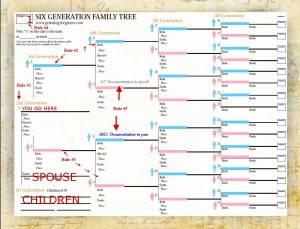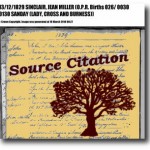Search results
Titanic Records Released for 100 Year Anniversary
April 10, 2012 by ramona
Filed under Articles, Latest News
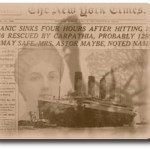 April 15th 1912 is the date that marks the sinking of the RMS Titanic. In remembrance of this, the 100th anniversary marking the loss of 1500 souls, a collection of over 200,000 records have been published.
April 15th 1912 is the date that marks the sinking of the RMS Titanic. In remembrance of this, the 100th anniversary marking the loss of 1500 souls, a collection of over 200,000 records have been published.
Included in the collection are:
- The Titanic’s Passenger List
- Information on Crew Members
- Coroners files
- Records about recovered bodies
Ancestry.com has released this data to correspond with the date of the ships sinking and until May 31 2012, access to this information is free. In addition to the above-mentioned records those interested in genealogy research involving the Titanic will have access to headstone photos of the 121 victims of the tragedy buried at the Fairview Cemetery in Halifax Nova Scotia.
Some exciting news for Titanic and Americana Historians is the inclusion of documents that reference John Jacob Astor IV (American Millionaire), Isador Straus (Macy Department store co-Owner) and Benjamin Guggenheim (businessman). Those who love celebrity genealogy will be thrilled to hear that the collection also include references to Margaret Brown who may be better known from movie fame as the “Unsinkable Molly Brown”.
Access to these records may aid Family Tree enthusiasts in solving their genealogy mysteries and lead to adding a few more names to your Family Tree Templates.
The Basics of Norwegian Genealogy
April 9, 2012 by ramona
Filed under Articles, Genealogy Searches by Place, Introduction to Genealogy, Latest News
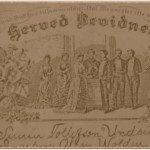 When tracing your Norwegian ancestors, you will learn that climbing your Norwegian Family Tree is a unique experience in genealogy research. From naming practices to language barriers and cultural differences, Norwegian genealogy is distinct in its resources and research techniques. In this article, Genealogy Beginner will pave your path with the basics of Norwegian genealogy research so you can start adding the names of your “Viking” forbearers to your family template.
When tracing your Norwegian ancestors, you will learn that climbing your Norwegian Family Tree is a unique experience in genealogy research. From naming practices to language barriers and cultural differences, Norwegian genealogy is distinct in its resources and research techniques. In this article, Genealogy Beginner will pave your path with the basics of Norwegian genealogy research so you can start adding the names of your “Viking” forbearers to your family template.
Ancestors From Norway: Getting Started
One of the first things you will need to understand about researching your ancestors from Norway is that the rules of following a single surname from generation to generation do not apply. Norwegian immigrants often took the name of the farm where they lived. This in itself can be a hint in your research. For example, in the case of two brothers, Johann Tollevson and Simon Tollevson who immigrated in the 1600’s one brother took the name Rugsveen and the other adopted the surname Undseth for the farms they were living on when they immigrated.
However once your research leaves the shores of North America your one name study ends. Prior to the 1900’s your Norwegian ancestors used a patronymic naming system where the child was given the first name of their father as a surname. In these cases, you will find, as in the case of the two brothers named above – Johann and Simon – that their fathers name was Tollev.
To get started digging for your Norwegian roots you will need your ancestors “Norwegian” name and date of birth along with the farm name where your ancestor lived. Although this may seem a little odd at first you will soon find that these peculiarities of Norwegian genealogy may be very helpful when searching out your ancestors from Norway.
Hints:
Norwegians were wonderful keepers of records and family bibles are very common
Norwegian dates are always written as…Day/Month/Year
Tools for Norwegian Genealogy
Once you have sorted out the names and dates of birth it is time to start gathering your research tools. Here is a short list to get you going.
– Family Tree Template
– Norwegian English Dictionary
– Word list for special terminology
Norway’s Genealogy Resources
Norway Church Registers
There are church registers for every parish in Norway with the oldest dating back to the mid 1600’s for some parishes. Records were recorded as both religious and and civil events for example a birth would be a civil event while a baptism is a religious event. Among the records of births, marriages and deaths you will often find entries of announcements made to the parish.
Norway Census
The earliest census in Norway took place in the 1600’s, these early census were called “Prestenes manntall” and recorded information for men, boys and sometimes widows. Sadly, Norway’s census records are incomplete and contain several errors, often with large parts of families missing. Beginning genealogists should know that Norwegian census is not considered a reliable source of information.
Bygdebok
Possibly the best resource for tracing your Norwegian ancestors is the Bydebok, a book of land records that contains a great deal of historic information. It often records a history of the families who owned the land… often into the 1300’s. Bygdebok are divided by communities listing the farms within one or two parishes and are a must have for anyone studying their Norwegian family history.
Other records available to genealogists are Probate, Mortgage and Tax Registers although like the census, the records are often incomplete.
The good news for anyone doing research on his or her ancestors from Norway is that there is a lot of information available on the internet. Join us on the Genealogy in General forum for a list of important links to get you started on your Norwegian genealogy.
Using DNA to Grow Your Family Tree: Guest Blog
April 5, 2012 by ramona
Filed under Articles, Getting Started in Genealogy, Introduction to Genealogy, Latest News
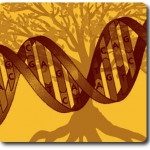 Genealogy Beginner Welcomes Guest Bloggers from the Sinclair DNA One name Study and the Salian DNA Project who have so wonderfully explained everything a genealogy beginner needs to know about how to use DNA testing to help with your genealogy research…and fill out your Family Tree Template!
Genealogy Beginner Welcomes Guest Bloggers from the Sinclair DNA One name Study and the Salian DNA Project who have so wonderfully explained everything a genealogy beginner needs to know about how to use DNA testing to help with your genealogy research…and fill out your Family Tree Template!
So what do you do when there are no more records to get you any further back in time on your family tree? Most of us get stuck at a brick wall which seems insurmountable and that’s where DNA comes in. By joining a DNA project and testing a male family member, you can compare that Y-DNA sample with others of the same surname.
Your Family Tree DNA: How It Works
Y-DNA is passed from father to son and contains a unique signature passed through the generations, which you share with the other project members. Another advantage is contact with others of the same surname to compare paper trails with and on top of that, you’ll find more relatives you didn’t have a clue existed, based all around the world.
In terms of cost, the least investment you can get away with is a 37 marker test and that would provide you with other matches of the same haplogroup as yourself. To be honest though, a 67 marker test though more costly, is far more revealing and those you matched at 37 markers will appear less closely related, whilst at 67 markers you can be fairly confident that those you match are descended from the same ancestor.
The closeness is measured in “genetic distance”; for example you could match exactly, or be one, two or more steps away in genetic distance from the other matches which will give a rough indication of how far back in time you relate to them.
DNA ONE-NAME STUDIES
There are plenty of one-name DNA studies on the internet but the majority of them use the www.FamilyTreeDNA.com laboratory for testing, mainly because they have the largest DNA database with 366,840 participants at the time of writing.
Some of these projects specialise in specific geographic areas and some in various ethnicities. For example, there are dedicated projects for those with Jewish, African or Native American ancestry as well as over 6,800 surname projects.
Not only can you compare your DNA with others of your own surname, you will be able to find matches across the whole of FamilyTreeDNA’s massive database as well which, strange as it may sound, can be extremely helpful in research terms.
Many adoptees have used DNA testing to find out who they really are by comparing their DNA results to the other surnames which show up in their matches, giving more clues to research their family history. You can join as many projects as you like or as many as are relevant to your family’s history and the other advantage of joining a project is a discounted price on the cost of your DNA test.
Just to be fair, there are other companies out there for example:
- Ancestry
- 23andme
- The Sorensen Molecular Genealogy Foundation
Who may be cheaper to test with than FamilyTreeDNA, but once those test results are in, there are considerably fewer other “testees” to compare your sample with and in the world of DNA testing for genealogical purposes, database size is everything!
DNA TESTS
Because DNA testing is still a relatively new science, using it to find relatives is the new frontier. Exciting developments are happening all the time and one of the latest such tools are “SNP’s” or “single-nucleotide polymorphisms”. These are small “mistakes” in the copying of DNA which occur just once and are then passed unchanged from generation to generation forever after.
Because they are much rarer, they are far more accurate in determining whether you relate closely to another potential match or not. The good news is that after the initial expense of a 37 or 67 marker test; testing individual “SNP’s” becomes more affordable when you want to take the plunge. That at least is a general outline of what happens.
Your Privacy
Privacy may be a worry for some, but your DNA sample is allotted a kit number and only that is shown on any project website along with the name of your earliest known ancestor and geographical location for him. (That is, provided you have signed a release form). If not, your DNA remains anonymous and no one will have access to it or your contact information. It’s your choice.
DNA is definitely a bit overwhelming at first; it’s true there is a lot to learn for the novice and it’s a constantly evolving science with new breakthroughs happening all the time, but that’s where your project leader should step in and explain what it means for you personally and for the project as a whole; advise whether it’s worth testing this or that.
DNA Communities
Most projects have forums on Yahoo and Google or even on Facebook which are very informative and specifically targeted to the project or projects you have joined. There is nothing to stop you joining as many projects and forums as may be relevant to your family history.
A word of caution though; no one has all the answers yet and you should not jump in expecting that your project leader will necessarily be an expert in the DNA field, although in general they have access to population geneticists or other DNA boffins who are more than willing to help answer queries.
DNA and Realistic Expectations
Mainly these projects are run by slightly more experienced enthusiasts with the same goals as yourself. Also, you may or may not find someone else with a paper trail you can connect to yours immediately, so don’t expect miracles.
It may even take years for the magic to happen where you find that elusive document which connects you on paper as well as with DNA. However, the DNA alone, matching others in your project means you are related to them at some point since the adoption of surnames began around the 12th or 13th century and you have a shared history and that’s a fairly exclusive club!

The Salian DNA Project: A New Direction in Genealogy
Genealogy + DNA + Archaeology = An Exciting New Direction for Family Tree Fanatics
Just to illustrate what DNA plus historical and archaeological research can achieve for genealogy:
Archaeology and Your Family Tree
Archaeology is playing an important part alongside the historical record and the Y-DNA. From the archaeological record in recent years, two ancient gravesites containing multiple burials:
- one dated to 670AD in Ergolding, Bavaria in southern Germany
- another dated to between 1000 and 700BC in Lichtenstein in central Germany
Thirteen of the skeletons excavated have been DNA tested and the results from four of them, (one at Lichtenstein and three at Ergolding), were found to have a distinctive marker, the S21 SNP.
The Ergolding results are the most interesting of the two, as there were high-value grave goods found alongside the skeletons, indicating that these burials were related to the Merovingian royal household, (according to the archaeologists, Dr Vanek et al), hence the connection with the Salian Franks; the ancestors of the Merovingian dynasty.
When Archaeology Meets DNA
The S21 SNP was discovered back in 2004 by Professor Ken Nordtvedt of Montana State University who announced that it represented those with Frisian ancestry; [Frisia was located in what is now the Netherlands, Germany and Denmark on the North Sea coast of Europe] and the date for this SNP was determined to be approximately 4,000 years ago. We now know from subsequent research that there are several clades [or branches] below S21, which are younger than that.
Several SNPs have been discovered over the past year, which have added to our knowledge and brought us further forward in time to about 1,900 years ago. There is a clade (or branch) of this S21 SNP which is Frisian/Anglo-Saxon in origin because that is where the highest concentration of matching samples in the local population are found today, however, S21 has other clades within it as well, which may represent a different branches, perhaps from associated tribes. The Salian Franks were settled in Toxandria, in close proximity to Frisia, just directly south of there, in fact and their homeland became part of what we today know of as The Netherlands and Belgium.
Our ancestors were far more mobile than we perhaps imagine and moving around within northern Europe 4,000 years ago, intermingling with other tribes in other nearby areas, but with no documentation that far back, we are struggling through the fog of distant time. In the years to come, that fog may be eradicated altogether.
The Genealogy Aspect
A large number of participants in the Salian DNA Project are named Sinclair with ancestral links to Caithness, Orkney and Shetland. Through the work of population geneticists such as Dr Jim Wilson at the University of Edinburgh, we know that our ancestors carrying the S21 SNP have left more evidence of their existence in eastern Scotland and eastern England. Indicating that our ancestors crossed the North Sea and invaded Britain at some point back in time and while through historical research we can document our common ancestor as Rollo, a Norwegian Viking, our family shows no sign of matching Norwegian DNA, so the old history books may well need to be rewritten.
Dr Wilson’s research in Orkney and Shetland has isolated those Sinclairs carrying the S21 SNP as being descendants of the Earldom Sinclair line. His extensive database shows the majority of Sinclairs in Orkney carry this SNP in their DNA and historically, there were no Sinclairs in the islands until shortly before Earl Henry Sinclair was installed as Earl in 1379. His family, based at Roslin, in Midlothian on the east coast of Scotland also fits with the evidence found of the S21 SNP in Scotland.
Salian DNA
The Salian DNA Project was designed to link all associated surnames, which have a common male ancestor and show the S21 SNP in their Y-DNA. A large proportion of them are Sinclairs, but anyone, as long as they have that all-important S21 SNP in their Y-DNA, can join, just make contact at: http://www.familytreedna.com/public/ulvungardynasty/default.aspx
Through the Salian DNA study, we are gradually narrowing down the geographical area of our origins and we have learnt a lot over the years. By sharing research as well as our DNA results it has also become gradually clear that many people who adopted the Sinclair surname back in the past, were not actually related to one another.
Surnames began to be adopted very slowly after the Norman Conquest of Britain in 1066 and another complication is the problem of “non-paternity events” or illegitimate male children given their mother’s surname, adoption, or alternatively born as the result of an affair and raised as a Sinclair or St Clair.
DNA has a way of winkling out those who adopted the name for whatever reason and drilling down to find the genuine descendants of a known ancestor with a documented history in the geographical areas where a family was known to have been in the more recent past.
It’s an absorbing and contagious hobby, so come and join us when you’ve taken that all important DNA test!
To learn more about this exciting study please join us on the Discovery Panel Forum for some fantastic links.
Find Your Ancestors in Almanacs
April 1, 2012 by ramona
Filed under Articles, Genealogy Research Resources, Latest News, Sharing Genealogy Information
 Almanacs can be a great resource for genealogists and family historians. Along with weather predictions, advice for farmers and statistical information almanacs can contain tit bits of information about your ancestors that are not found in vital events documents or census. Additionally almanacs can give wonderful ephemeral information to round out your family history story and fill in your family template. Gutenberg printed the very first almanac in 1457 in Mentz, Germany and their use spread to almost every country by the 1600s. By the 1800s, it was possible to find yearly almanacs for nearly every county in Great Britain.
Almanacs can be a great resource for genealogists and family historians. Along with weather predictions, advice for farmers and statistical information almanacs can contain tit bits of information about your ancestors that are not found in vital events documents or census. Additionally almanacs can give wonderful ephemeral information to round out your family history story and fill in your family template. Gutenberg printed the very first almanac in 1457 in Mentz, Germany and their use spread to almost every country by the 1600s. By the 1800s, it was possible to find yearly almanacs for nearly every county in Great Britain.
The best way to demonstrate what a great resource an almanac can be is by looking in one for information. For this purpose “Peace’s Orkney Almanac and County Directory, 1886” gives us a great example of genealogical and family history information that.
The Family History Element
Within the front and back pages of the almanac, there is a wide range of advertisements that present a window into your ancestor’s daily lives.
From these advertising pages, we get a glimpse at the fashions of the times, modes of travel, an idea of how they may have approached emigrating to a new land and even some insight into daily chores.

Almanacs and Genealogy
An almanac contains a wealth of information in the trades sections. From listings of “Inspectors of the Poor” to a list of “Registrars of Births, Marriages and Deaths” that can be very helpful in pinpointing those questionable dates. Looking at this entry, we can see the timelines given to register any vital events.

Almanacs can also be used to help you find resources for records. Peaces Orkney and Shetland Almanac names all of the churches, clergy, schools and teachers in the county. It also gives the names of newspapers that were published at the time along with groups, society’s guilds and clubs, which are all fantastic sources of information for family tree research.
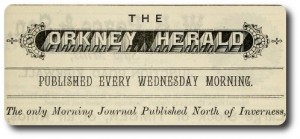
Additionally, it is common for almanacs to break up the directory listings by parish where you may find information that is more specific to your ancestor. Flipping to the directory for Sanday we find out that Peter Sinclair is listed as a member of the Parochial Board as well as a member of the School Board, which suggests he was an active member of his community. Not information found in a census, in fact almanacs are probably the number one place to look if you are searching for clues about your ancestors between census years.
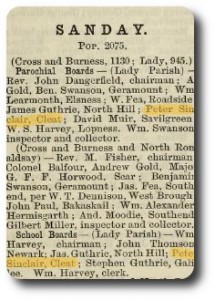
In this particular issue, we get lucky, as there is register of voters that not only lists the men but also gives a list of female municipal electors that predates women being given the right to vote in Great Britain. Looking at an almanac for genealogy can not only help locate ancestors and resources, it can also teach a few things that we may not learn from history books; such as areas where reform was more progressive. The pictures and stories of an almanac are one of those often forgotten information sources that can paint a surprisingly vivid picture of your family tree.
Image Credits: Ramona Hartley, Peaces Orkney Almanac and County Directory
Source: Internet Archives, National Library of Scotland
Rights: National Library of Scotland holds full rights in this digital resource and agrees to license the resource under the Creative Commons License: Attribution-Noncommercial-Share Alike 2.5 UK: Scotland.
Creative Commons license: Attribution-Noncommercial-Share Alike 2.5 UK: Scotland
Licenseurl: http://creativecommons.org/licenses/by-nc-sa/2.5/scotland/
Fill out Your Family Template the Easy Way
March 29, 2012 by ramona
Filed under Articles, Getting Started in Genealogy, Introduction to Genealogy, Latest News
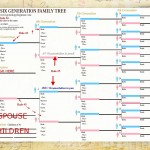 Have you ever felt confused about how to fill out a Family Tree Template?
Have you ever felt confused about how to fill out a Family Tree Template?
- Wondered what the numbers mean?
- Who you should include?
- Where to start?
Here are a few simple rules to follow that will have you filling out your Family Template in no time.
Family Template Rule #1 = YOU
Always start with yourself. Your name goes in the number one spot on the chart along with your vital statistics information such as when and where you were born. A space for the place and date of your marriage should be below that and if you look down many Family Tree Templates include an area to record the name of your spouse and children.
Family Template Rule #2 = MEN
Slightly indented and up from spot number one you should find the numbers two. This is where you will record your fathers name and information.
The rule if thumb:
- The males in your family will always have even numbers (2,4,6,8)
- The males in your family will always follow the upper track on a family template.
Family Template Rule #3 = WOMEN
Slightly indented and below number one you will find the number three spot
The Rule of thumb:
- The maternal lines of your family will always have odd numbers (3,5,7,9)
- The maternal lines of your family will always follow the bottom track on a Family Tree Template
Family Template Rule #4 = Generations
If you follow these rules through every generation, you will never be confused again. However, wait we are not quite finished yet. If you look on the upper left hand corner of your Family Template, you will notice a little box that says, “Chart#”. This area is needed for when you family tree goes beyond the number of generations on the chart.
Rule of Thumb:
- The template that includes you and your immediate family is always number one
- Number your Family Tree Templates consecutively to avoid confusion. For example if you were starting on a seventh generation, you would need to begin another Family Template and that template would be number two.
Note: Just below the “Chart #” box, there is a space that says “Note: “1” on this chart is the same as ____ on chart ____. This section is to help keep you organized when working with multiple Family Tree forms. For example if you were making a desendance report, this gives you a quick reference to where you can be found in the report.
Family Template Rule #5 = Documentation
All good genealogy research endeavors to document findings with copies or originals of birth, marriage and death records.
Rule of Thumb:
- Use a pencil to fill out the names for individuals for which you do not have documentation
- Use a pen to fill out the names for individuals for which you do have documentation
Family Template Rule #6 = Extended Family
Your Family Template is for your direct line of ancestry
Rule of Thumb:
- Uncles, aunts and cousins are not included on your Family Tree Template.
Here is a visual cue to help you get started (Click for a larger view)
Now that you are ready to begin filling in your family’s generations all you need is a Family Tree Template, just follow this link and download your FREE FAMILY TEMPLATE today.
Genealogy & Newspapers: Obituaries
March 25, 2012 by ramona
Filed under Articles, Genealogy Research Resources, Latest News, Sharing Genealogy Information
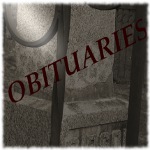
One single record may tell you more about your ancestor than a death, marriage and birth certificate combined and that is their obituary. Obituaries can provide information about your ancestor that cannot be found in civil and church records and that makes them one of the best sources of genealogical information available. Before death certificates were even required obituaries had already long existed.
The Value of Obituaries to Genealogical Research
Even when you have already obtained all of the official records for your ancestors, an obituary can help fill in the gaps between years. Obituaries frequently impart valuable information about events that happened in the years between birth, marriage, the census returns and death.
For example, an obituary can identify children you may have missed. Often when we look at a timeline of our ancestor’s childbearing year’s we see that births occur in a pattern. Such is the case with my ancestors Peter Sinclair and Catherine Calder.
Children of Peter Sinclair and Catherine Calder m. 1854:
- James Sinclair b. 1855
- Isabella (Bella) Sinclair b.1857
- Catherine Drever Sinclair b. 1859
- Richard Sinclair b.1861
- William Sinclair b.1862
- Jean Sinclair b.1867
- Peter Sinclair b.1870
- Robert Sinclair b.1874
You can see by the example that from their first child to their fifth child there was two years between births. Then the pattern breaks with a five-year gap between the fifth and sixth child, a three-year gap between the sixth and seventh child and a four-year gap between the last two.
Gaps like this indicate the possible loss of a child. If you find gaps such as this that lie between census years and no record of birth or death has been found, an obituary is the logical place to look.
Your Ancestors Obituary
Here is a quick look at some of the other information that can be found in an obituary.
- Dates of birth, marriage and death
- Place of birth, marriage and death
- Name of parents and grandparents
- Number of children and grandchildren
- Names of children and grandchildren
- Residences and Occupations
- Memberships to clubs or societies
- Religion and church attended
- Military Service information
- Cause of death
Where to Find Obituaries for Your Family Tree
When you think of obituaries, the primary resource that comes to mind is newspapers. That is certainly a logical conclusion, the next questions are where to find the newspapers and if you are researching from a distance how to access them.
A great source for this information is online obituary indexes. Obituary indexes such as the Library of congress’s “Chronicling of America” provides searchable, free, online access to a huge database of newspapers from 1836 – 1922. If the newspaper you are looking for were not accessible online your next strategy would be to locate an obituary look-up or mailing list.
Although newspapers are recognizably the main source of obituaries, they are only half the story. Obituaries and obituary indexes can also be found in published journals, such as the “Obituaries Index Prior to 1800 by Sir William Musgrave” an index to the obituaries of “memorable persons” of England, Scotland and Ireland. This publication and others like it hold a treasure trove of ancestral information that may point out obituaries published in books, university papers, magazines and memoirs. All great sources that get you closer to adding another generation to your family template.
If you have any tips to share on researching obituaries or any questions about this wonderful source of ancestral information, join us on the Genealogy in General forum.
Image Credit: Ramona Hartley
Free Immigration Records: Ellis Island Site Calls for Help
March 20, 2012 by ramona
Filed under Articles, Latest News
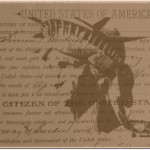
These days genealogy sites that give free access to records are few and far between. One of the few sites that do provide free use is The Ellis Island Immigration site. If you have used the Ellis Island site to find your ancestors immigration records you already know what a valuable resource it is to family tree climbers. Can you imagine what a tragedy it would be to the genealogy community if that access were lost?
This week a story in The Tribune Star by Tamie Dehler, calls out on behalf of the Statue of Liberty/Ellis Island Foundation. The foundation, responsible for making free immigration records available to genealogists and family history researchers is a non-profit organization that relies heavily on public support for continued free access to these important records.
In their message to the public, the foundation says:
“In order to continue to provide free access to our valuable archive of immigration records … we need to ask our friends to step in and play a part with a critically needed contribution. For more than 10 years, these immigration records have been free for you to explore. But our site and content are costly to maintain, operate day-to-day, and continually improve. We’re a non-profit, so your tax-deductible contribution is essential to our work. And in tough times like these, whatever donation you make goes even further than you can imagine in keeping Ellis Island Online free.”
Your support in the form of a yearly membership will help The Statue of Liberty-
Ellis Island Foundation, Inc. keep this invaluable service open to genealogists. Membership costs total $45.00 per year and are 100% tax deductible.
Visit The Statue of Liberty-Ellis Island Foundation, Inc and support the foundation that has helped so many.
Image Credit: Ramona Hartley
Genealogy Pitfalls: Genealogy Beginners Beware
March 9, 2012 by ramona
Filed under Articles, Getting Started in Genealogy, Introduction to Genealogy, Latest News
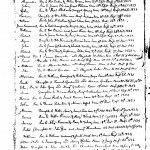 Recently while researching a family line, I discovered what I hoped might be a breakthrough on a frustrating brick wall. What I actually found was a good reason for beginning genealogists to use caution before including individuals in their family tree without first confirming the source. Truth to tell, this is a sad tale of how genealogy misinformation and mistakes are spread.
Recently while researching a family line, I discovered what I hoped might be a breakthrough on a frustrating brick wall. What I actually found was a good reason for beginning genealogists to use caution before including individuals in their family tree without first confirming the source. Truth to tell, this is a sad tale of how genealogy misinformation and mistakes are spread.
This story starts with a search for the parents of John McCallum b. about 1785.
I know that John was born on approximately this date from one source.
Monumental Inscriptions: Carnwath, County of Lanark for John McCallum
Death, noted: By Peter and J. McCallum to Fa. John 16/9/ 1839} 54; John McC. s. of Jas. 27/5/1865} 20; Janet Gibson w. of said John McC. 25/11/1876} 86; Said Jas McC. 27/6/1898} 81; Marion Law 9/4/1904} 83; their gdr nurse janet McC. 30/8/1902} 22.
I know the above named is my John McCallum from three separate sources:
1. From Statutrory Index 1916 – 1876 for the death of Janet McCallum:
Death November 25th, 1876
Fauldhouse, County of Linlithgow
At Rosebank, Fauldhouse, Parish of Whitburn
JANET MCCALLUM, 86, Widow of John McCallum, labourer
daughter of:-
F. Alexander Gibson………..deceased
M. Christine Gibson, m.s. Weir…deceased
Cause: Chronic Brights disease, 10 months
as cert. by John Crawford L.R.C.S.E.
Informant Isaac McCallum, Son, Present.
2. Statutory Index pre 1855 births 1824 & 1823 for the birth of William to John McCallum and Janet Gibson and consulted OPR 632/3 Carnwath, County of Lanark.
Birth: “William son to John McCallum and Janet Gibson born Oct. 4, Baptized 26th 1823.”
3. Statutory Index 1913-1916 for the death of William McCallum, In West Calder
Death: 1916, January 24th
West Calder, County of Midlothian
at 5 Davy street, Addiwell, West Calder
William McCallum, 92, Traffic Manager, Widower of Martha Walker.
Son of :-
F. John McCallum, Laborer…deceased
M. Janet McCallum, m.s. Gibson…deceased
Cause, Senile Decay, 1 month. As cert. by John Young, L.R.C.P.&S.E.
Informant James McCallum, Son.
Anatomy of an Ancestor Hunt
What I want to know is who Johns parents were, unfortunately Carnwath marriages are blank from 1735-1826. Additionally I have been unable to find a death record for John; two documents that could contain the information I need.
While searching for source documents or any clues as to the parentage of my John I ran across several family trees on the internet that named both my John, his wife and their children. A total of three family trees on Ancestry.com and one website, all naming John’s parents as John McCallum and Catherine Gray from Kilmicheal, Glassary, Argyll, Scotland
A Family Tree Cautionary Tale
Following this trail, I checked to see what sources they had cited…I found none listed. Still hopeful, I wrote to every lead and asked if they could help me locate the source they had used. Two Ancestry.com users answered that they had found the information from the other Ancestry.com tree and had not checked on the source. The other did not respond.
The website owner was lovely and sent me a copy of the birth registration from the OPR, here is a transcript.
09/01/1785 McCallum, John [OPR Births 511/000010 0061 Glassary]
“John McCallum Ashdaherlic & Catherine McCallum had a child named John”
Sadly, this is far from conclusive as there are eight other possible parents for my John McCallum b. 1785. (Note: this document does not give the mothers maiden name).
All couples listed below also had a son born 1785 named John McCallum.
- Donald Mccallum, Jean Graham ABERFOYLE,PERTH,SCOTLAND
- John Mccallum, Agnas Mcjock BUCHANAN, STIRLING, SCOTLAND
- Peter Mccallum, Janet Mclaren KENMORE,PERTH,SCOTLAND
- James Mccallum, Mary Forsyth BARONY,LANARK,SCOTLAND
- John Mccallum, Christian Jackson GLASGOW,LANARK,SCOTLAND
- Daniel Mcallum, Ann Mcallum STIRLING, STIRLING, SCOTLAND
- Hugh Mcallum, Katharine Mcfarlane BONHILL,DUNBARTON,SCOTLAND
- Daniel Mcallum, Ann Mcallum STIRLING, STIRLING, SCOTLAND
The Moral of the Story
As you can see from this story, it is very important to find documented sources before including someone in your family tree and publishing the information. It is just as important to remember that genealogy research sites are tools. Ancestry.com states “don’t take un-sourced documents at face value”. Finding your ancestor listed on someone else’s tree is not proof. Without a documentable source or two to back up your research you are simply guessing.
To learn more about avoiding pitfalls, citing sources and the standards of good genealogical research check out, Lesson 1: Beginning Genealogy – The Big Five.
Image Credit: Ramona Hartley
How to Cite Family Tree Information Sources
March 2, 2012 by ramona
Filed under Articles, Genealogy Standards & Guidelines, Introduction to Genealogy, Latest News, Lesson 1 Articles
As a family tree enthusiast, you are probably aware that your genealogical information comes from multiple places such as government agencies, Old Parish Records, monumental inscriptions, online genealogy sites, books and newspapers. No matter where you found the information about your ancestors it is simply good practice to cite your sources. The basics of citing a source are simple.
Citing a Genealogy Source Consists of Naming:
- Who created the source (publisher, historical society, government agency)
- What the source was titled (John O’ Groat’s Journal)
- When the information was created (copyright or year of publication)
- Where the information was created (State, County, and/or name of publisher)
- How you found it (name of repository or archive)
- Why it is a good source (primary, secondary or tertiary source)
Citing sources is particularly important if you plan to publish your family tree to the internet and it helps all of us involved in family tree research to sort out the reliable information from assumptions and guesswork.
Citing Sources for the Genealogy Beginner Citing sources can also be time consuming and confusing if you are not familiar with how to cite properly a source of genealogical information. For starters, here are some general helps and guidelines to citing a source.
Genealogy Citation Guidelines:
- <angle brackets> are for internet addresses <https://www.genealogybeginner.com/>
- [brackets] are for descriptive information
- Information about publishers should be in
- (parentheses)
Always cite exactly what you have found along with where you found it If you have doubts either leave it out or note is as a supposition.
For example in the case of a Monumental Inscription:
PETER SINCLAIR, CATHERINE CALDER Erected By Peter Sinclair In Memory Of His Wife Catherine Calder Who Died At Greentoft, 21st March 1905, Aged 72 Years. Also Peter Sinclair, Born At Cleat, Sanday, 12th June 1830, Died At Greentoft, Eday, 3rd January 1917
Citation:
Orkney Family History Society , “Orkney Graveyard Search for: Sinclair in Eday & Pharay, Old Kirkyard, St Marys, Eday Orkney” (Orkney Family History Society ) [Ray Millar ] <http://www.orkneyfhs.co.uk/mis/minscriptions.php?opt=gyard&gref=151&surname=Sinclair> Report date: 04/03/12
note: Eday, Orkney, Scotland: Eday Old Kirkyard, Orkney, Scotland Plot: 329
It also helps to become familiar with the abbreviations used in citing your family tree information sources along with the standard formats used. Standard
Abbreviations for Genealogical Citations

Standard Format for Online Genealogical Citations
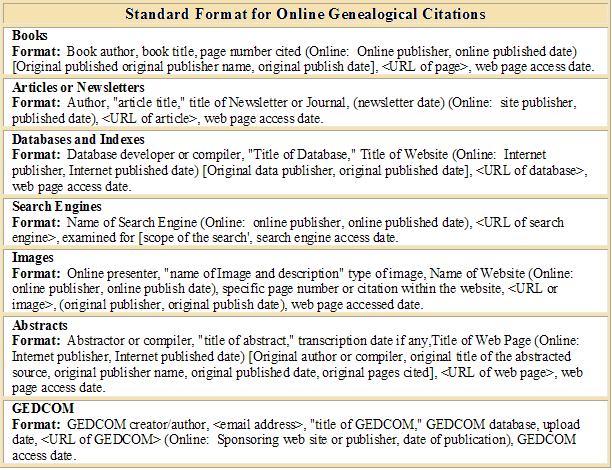
Citing your sources will give you the confidence to publish your family tree knowing that all of your hard work is beyond reproach. You can learn more about the importance of citing your family tree research and genealogy best practices in Genealogy Beginner’s Lesson 1: The Big Five Genealogy standards and guidelines: what you need to know first
Image Credit: Ramona Hartley
Genealogy News: Accessible Archives
February 29, 2012 by ramona
Filed under Articles, Latest News
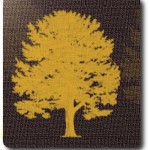 Accessible Archives has been a well-kept secret for far too long. The company founded in 1990 has made an impressive amount of archived information (at one time only offered through microfilm) available through computer technology.
Accessible Archives has been a well-kept secret for far too long. The company founded in 1990 has made an impressive amount of archived information (at one time only offered through microfilm) available through computer technology.
Accessible Archives has excellent search capacity that allows family history buffs to pinpoint very specific information that is then presented in digital format or through direct link.
Collections for Family History
This invaluable resource for genealogists contains mainly “PRIMARY SOURCE” materials! Filled with mostly US based content, Accessible Archives has a huge collection of newspapers and books from the 1700’s to 1800’s.
Some of the items in their collection that have the greatest genealogical value include:
- African American Newspapers
- Frederick Douglass’ Paper
- Freedom’s Journal
- Provincial Freeman (Canadian Publication)
- American County Histories to 1900
- Delaware and Maryland County Histories
Maine County Histories
New York County Histories
Vermont County Histories
- Delaware and Maryland County Histories
- The Civil War Collection
- Part I: A Newspaper Perspective
- Part II: The Soldiers’ Perspective
- Part III: The Generals’ Perspective
- Part IV: A Midwestern Perspective
- Part V: Iowa’s Perspective
- Part VI: Northeast Regimental Histories
Access for Genealogists
Access is available on a two-tier platform that includes institutions and individuals. For individual access, there is a yearly membership fee of $59.95 payable via internet by credit card, debit card or PayPal. However, before you sign up for Accessible Archives check with you local library, college or university as they may already have a membership.
In addition to Accessible Archives, amazing collection, the site hosts a news section, webinars and a blog filled with shared resources. Overall Genealogy Beginner gives Accessible Archives a very high rating as one of the best internet resources for family tree enthusiasts as well as historians.
Image Credit: Ramona Hartley

